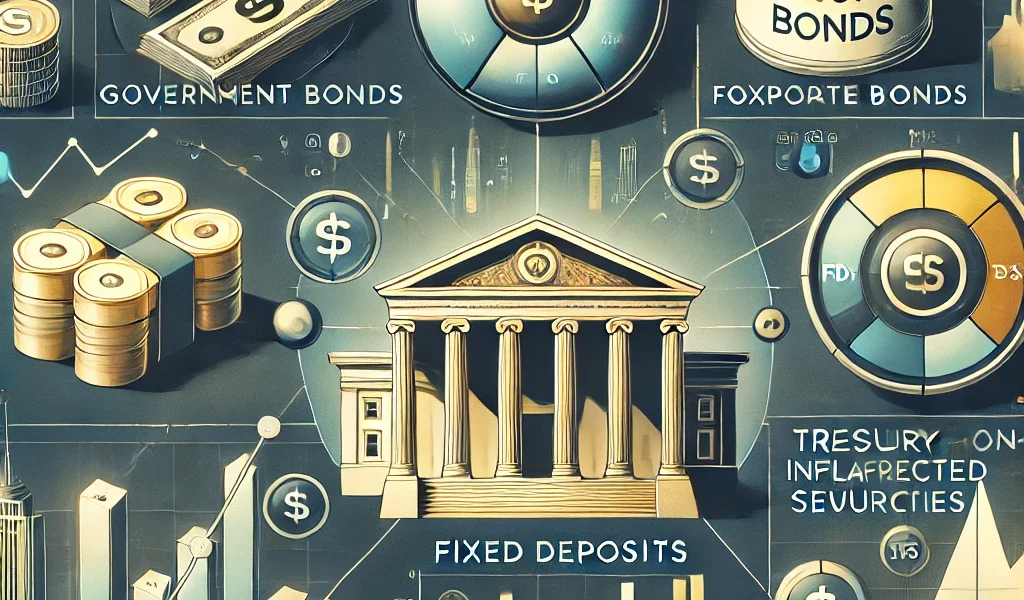Introduction
Investing in fixed income securities is a great way to ensure stable returns while minimizing risks. These investments provide regular interest payments and are less volatile than equity investments, making them an excellent choice for conservative investors or those looking to diversify their portfolios. In 2025, there are several fixed-income investment options that offer safety, predictable earnings, and steady returns.
In this blog, we will explore the best fixed-income investment options, their benefits, risks, and tips for selecting the right one based on your financial goals.
1. What Are Fixed Income Investments?
Fixed income investments are low-risk financial instruments that provide consistent interest payments over a fixed period. These investments help investors secure stable returns and preserve capital, making them ideal for risk-averse individuals.
Key Features of Fixed Income Investments:
- Steady Income: Regular interest payments provide financial stability.
- Lower Risk: Less volatile compared to stocks and other market-driven investments.
- Capital Preservation: Helps maintain principal amount while earning returns.
- Diversification: Reduces portfolio risk by balancing equity investments.
- Predictable Returns: Interest rates are fixed or adjusted periodically, ensuring clarity in earnings.
2. Best Fixed Income Investment Options for 2025
1. Government Bonds (Best for Safety and Guaranteed Returns)
Government bonds are one of the safest fixed-income options since they are backed by the government. They offer periodic interest payments and return the principal at maturity.
- Interest Rate: 3% – 6% (varies by country and tenure)
- Risk Level: Low (Government-backed security)
- Liquidity: High
- Pros:
- Highly secure investment
- Ideal for risk-averse investors
- Suitable for long-term wealth preservation
- Cons:
- Lower returns compared to equities
- Long lock-in periods for some bonds
2. Fixed Deposits (FDs) (Best for Guaranteed Fixed Returns)
Fixed Deposits (FDs) are a popular investment option offered by banks and financial institutions, providing a fixed interest rate for a set period.
- Interest Rate: 4% – 8%
- Risk Level: Low
- Liquidity: Moderate (Penalty for early withdrawal)
- Pros:
- Guaranteed returns with no market risks
- Flexible tenure options
- FDIC or similar insurance available (depending on the country)
- Cons:
- Inflation may reduce real returns
- Interest is taxable in some regions
3. Corporate Bonds (Best for Higher Yields with Moderate Risk)
Corporate bonds are debt securities issued by companies to raise funds. They offer higher returns than government bonds but come with slightly higher risks.
- Interest Rate: 5% – 9%
- Risk Level: Moderate
- Liquidity: Moderate to High
- Pros:
- Higher interest rates than government bonds
- Suitable for medium- to long-term investment
- Cons:
- Credit risk (depends on company financial health)
- May have lower liquidity than government bonds
4. Treasury Inflation-Protected Securities (TIPS) (Best for Inflation Protection)
TIPS are government-backed securities designed to protect investors from inflation. The principal value adjusts with inflation, ensuring purchasing power remains intact.
- Interest Rate: 1.5% – 3.5% (adjusted for inflation)
- Risk Level: Low
- Liquidity: High
- Pros:
- Protects against inflation
- Government-backed security
- Cons:
- Lower yields than regular bonds
- Market fluctuations can impact short-term value
5. Municipal Bonds (Best for Tax-Free Income)
Municipal bonds are issued by local or state governments to fund public projects. They offer tax advantages, making them an attractive option for high-income investors.
- Interest Rate: 3% – 6%
- Risk Level: Low to Moderate
- Liquidity: Moderate
- Pros:
- Tax-free interest income (varies by country)
- Ideal for long-term income planning
- Cons:
- Some credit risk
- Interest rates can be lower than corporate bonds
6. Certificate of Deposit (CDs) (Best for Short-Term Safety)
Certificates of Deposit (CDs) are time deposits offered by banks with fixed interest rates and locked-in periods.
- Interest Rate: 3% – 7%
- Risk Level: Low
- Liquidity: Low (Penalty for early withdrawal)
- Pros:
- Guaranteed returns
- Safe investment with FDIC insurance (country-dependent)
- Cons:
- Early withdrawal penalties
- Inflation risk can reduce real earnings
7. Bond ETFs & Mutual Funds (Best for Portfolio Diversification)
Bond Exchange-Traded Funds (ETFs) and mutual funds pool money to invest in a variety of bonds, offering diversification and passive income.
- Interest Rate: Varies (Depends on fund strategy)
- Risk Level: Low to Moderate
- Liquidity: High
- Pros:
- Diversified exposure to multiple bonds
- Professional management
- Cons:
- Management fees apply
- Returns depend on market conditions
3. How to Choose the Right Fixed Income Investment
1. Risk Tolerance
Assess your risk appetite before selecting a fixed-income investment. Government bonds and FDs are low-risk, while corporate bonds and bond ETFs have moderate risks.
2. Investment Horizon
Consider your time frame. If you need short-term security, opt for CDs or FDs. For long-term growth, municipal bonds or TIPS are good choices.
3. Interest Rates & Inflation Impact
Check if the interest rate is competitive and whether inflation-adjusted options like TIPS can offer better protection.
4. Liquidity Needs
If you need access to funds, choose highly liquid investments like bond ETFs or government bonds instead of long-term CDs or FDs.
| Investment Type | Best For | Risk Level | Liquidity |
|---|---|---|---|
| Government Bonds | Safety & Stability | Low | High |
| Fixed Deposits | Guaranteed Returns | Low | Moderate |
| Corporate Bonds | Higher Yield | Moderate | Moderate |
| TIPS | Inflation Protection | Low | High |
| Municipal Bonds | Tax-Free Income | Low to Moderate | Moderate |
| CDs | Short-Term Safety | Low | Low |
| Bond ETFs | Diversification | Moderate | High |
4. Conclusion
Fixed-income investments provide a stable and reliable way to grow wealth while minimizing risk. Depending on your financial goals, government bonds, FDs, municipal bonds, or bond ETFs can be excellent choices. Diversifying across different fixed-income instruments ensures consistent returns while safeguarding your capital.
Disclaimer:
This blog is for informational purposes only and should not be considered financial advice. Always consult with a financial advisor before making any investment decisions.




